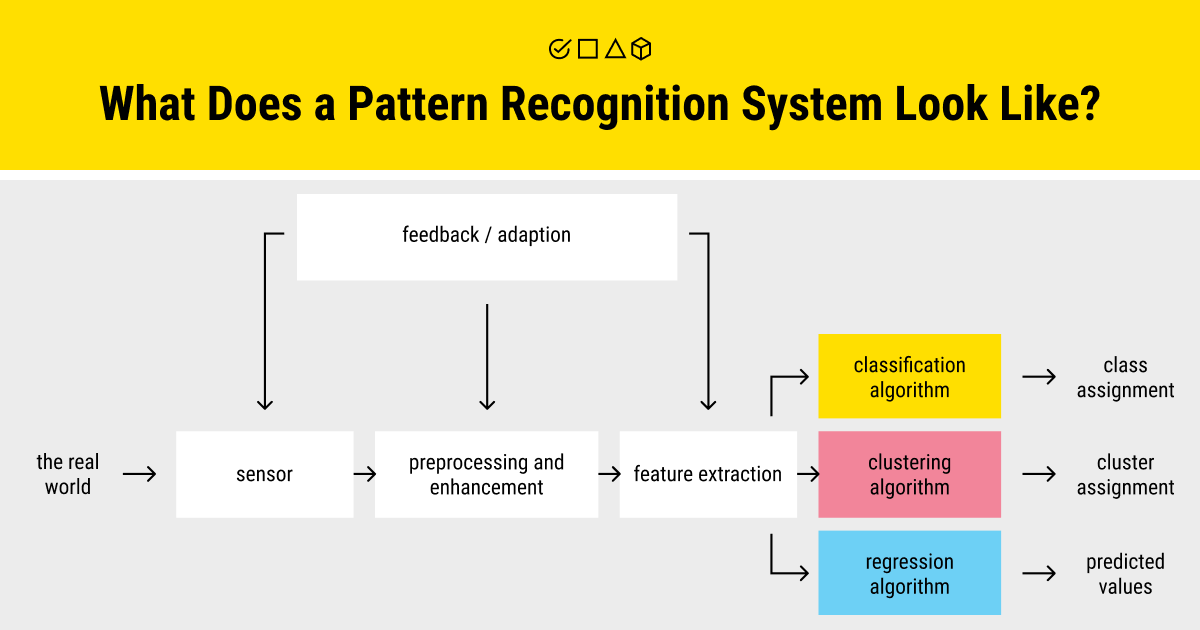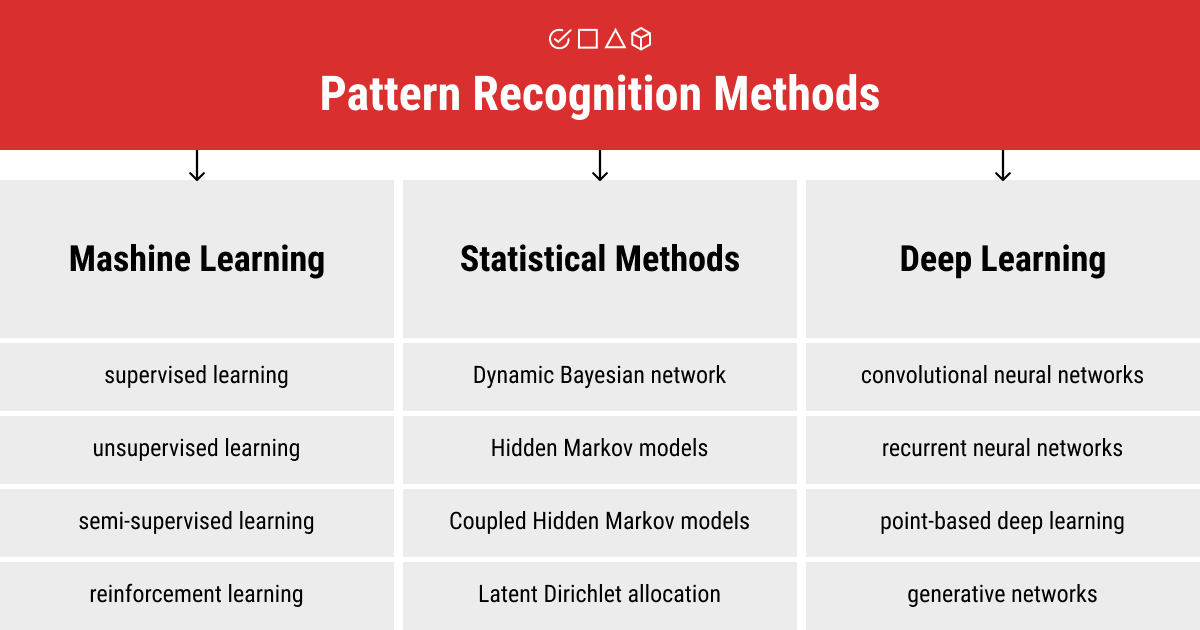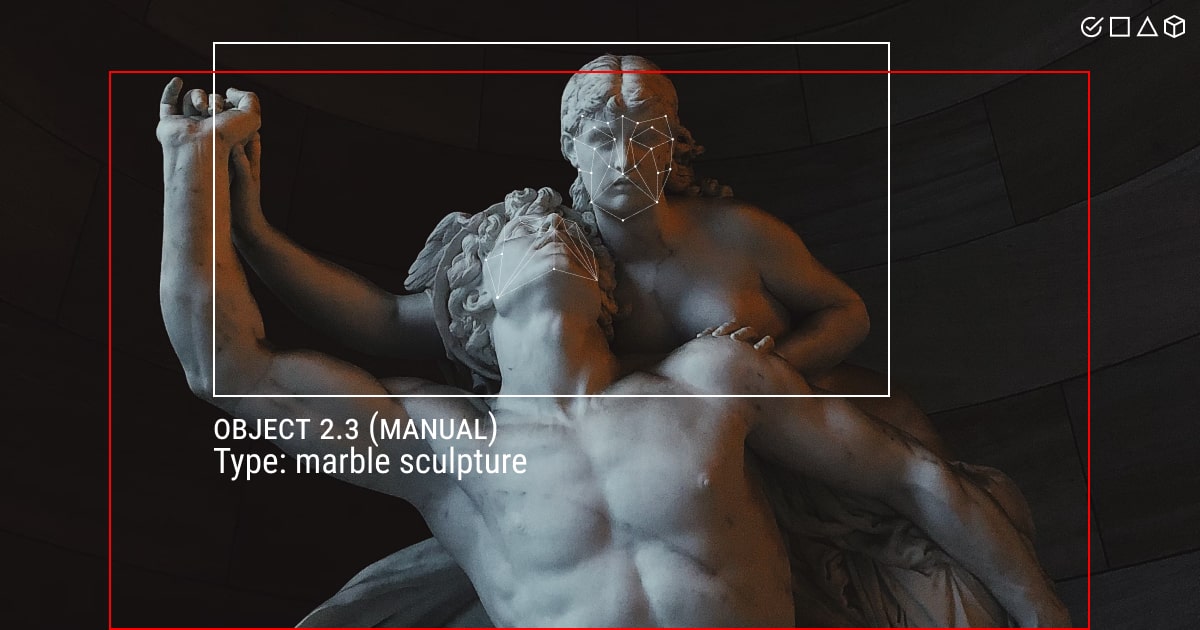Pattern Recognition and Machine Learning: Industry Applications
Table of Contents
- TL;DR
- What Is Pattern Recognition and Machine Learning: Definition and Types
- Pattern Recognition Algorithms: How Do They Work?
- Pattern Recognition and Machine Learning Process Overview
-
Industry Applications of Pattern Recognition and Machine Learning
- Healthcare: Diagnostic Imaging and Disease Prediction
- Finance: Fraud Detection and Risk Assessment
- Retail: Personalized Recommendations and Demand Forecasting
- Manufacturing: Predictive Maintenance and Quality Control
- Transportation: Autonomous Vehicles and Traffic Management
- Security: Biometric Authentication and Surveillance
- Agriculture: Crop Monitoring and Yield Prediction
- Energy: Fault Detection and Grid Management
- Seismic Analysis: Earthquake Prediction and Monitoring
- About Label Your Data
-
FAQ
- How is pattern recognition used in machine learning?
- What is the best model for pattern recognition in ML?
- Is pattern recognition and machine learning outdated?
- Is AI good at pattern recognition?
- What is the difference between pattern recognition and algorithm?
- Which is an example of a type of machine learning algorithm is pattern recognition?

TL;DR
- Pattern recognition enables machines to identify complex pattern data.
- Key applications span industries, including image processing, NLP, finance, and healthcare.
- Methods vary, from statistical and syntactic to neural network approaches, depending on data type and goal.
- Successful pattern recognition relies heavily on large, high-quality datasets and optimized ML models.
- As AI advances, pattern recognition will continue driving improvements in automation, efficiency, and accuracy across industries.
What Is Pattern Recognition and Machine Learning: Definition and Types

Pattern recognition is arguably the most fundamental cognitive skill for humans that helps us perform high-level decision-making. Machines, however, pursue this skill of recognizing complex pattern data to solve challenging issues in machine learning. This helps humans achieve the ultimate success in automating manual tasks and handing most of them over to advanced technologies.
Do you use Apple’s Face ID or fingerprint identification to unlock your phone? Or maybe you’ve been searching for a new song using Shazam? Are you the owner of a self-driving vehicle that recognizes objects on the street by itself? All of these are prime examples of sophisticated pattern recognition systems that are widely applied across different industries and in our lives.
Definition
Pattern recognition and machine learning are frequently used interchangeably. Is that correct? Well, not exactly. So, what is pattern recognition?
It’s a data analysis technique, which uses ML algorithms to find patterns and regularities in data in the most accurate and fastest way possible.
Pattern recognition is one of the methods of how machine learning can be used to solve complex issues in the field. ML algorithms help these systems recognize incoming patterns and teach machines to observe the environment and distinguish objects in it.
It is an automatic process based on different types of data inputs, including images, videos, text, audio, digits, and other identifiable qualities. Machine learning underpins pattern recognition systems to allow them to analyze incoming data, find the pattern, and make logical inferences.
Pattern recognition is a mature but constantly evolving field, the foundation for advances in computer vision (CV), image recognition, and NLP tasks (Natural Language Processing).
Types
There are different paradigms used to denote the practical issues that pattern recognition and machine learning deal with. However, the most important ones are statistical and syntactic pattern recognition.
Statistical Pattern Recognition
This pattern recognition method uses statistical historical data to learn from examples. The system collects observations, processes them, and learns to generalize and apply these principles to new observations. It’s a statistical method for analyzing data measurements to extract information and generate logical decisions.
Syntactic Pattern Recognition
Also known as structural pattern recognition, this type of recognition works with primitives, aka simpler subpatterns. The identified pattern itself is characterized based on the connections between the primitives. Here, each object is interpreted by a variable-cardinality set of symbolic, nominal features.
Neural Pattern Recognition
As the name suggests, this type of pattern recognition uses ANNs, which we’ll discuss in more detail later. Neural networks have the ability to solve complicated nonlinear input-output relationships and adapt to the data.
Template-Matching Pattern Recognition
This pattern recognition and machine learning technique is used to build simple models that can establish similarities in two images and store the matched patterns in the form of templates. However, this approach is ineffective at detecting patterns that are distorted.
Hybrid Pattern Recognition
As it usually happens in AI, there’s no one-size-fits-all algorithm that can solve all the cases in pattern recognition. Thus, sometimes it makes sense to go for a hybrid approach and build a model based on multiple classifiers to recognize patterns in data. Each classifier is trained using feature spaces.
Pattern Recognition Algorithms: How Do They Work?

Machine learning for pattern recognition implies the use of algorithms that typically seek to produce a viable solution for all potential inputs and perform matching of the inputs, considering their statistical volatility. The type of label output, ML method (supervised or unsupervised), and the type of algorithm itself (statistical or non-statistical) are all factors that influence the pattern recognition algorithms.
Most pattern recognition and machine learning systems are data-intensive, so these systems’ accuracy is directly dependent on the quantity and quality of the training data. In most cases, the ML systems are trained on labeled data through a data annotation process. However, other pattern recognition algorithms can also be used to identify unknown patterns in unlabeled data (unsupervised learning).
Bias in training data often leads to inaccurate predictions. Introducing controlled randomness during training ensures models handle non-traditional patterns better, yielding stronger performance.
Classification Algorithms (Supervised ML)
Parametric:
- Linear discriminant analysis
- Quadratic discriminant analysis
- Maximum entropy classifier (logistic regression, multinomial logistic regression)
Non-parametric:
- Decision trees, decision lists, Random Forest classifier
- Naive Bayes classifier
- Kernel estimation and K-nearest-neighbor algorithms
- Neural networks
- Support vector machines
- Gene expression programming
Clustering Algorithms (Unsupervised ML)
- Deep learning methods
- Categorical mixture models
- K-means clustering
- Hierarchical clustering
- Correlation clustering
- Kernel principal component analysis (Kernel PCA), TSNE
Pattern Recognition and Machine Learning Process Overview
Pattern data is represented by a physical object that one can observe or an abstract concept. In general, a pattern is a term for how we characterize an item (e.g., describing a flower). Patterns have different classes as well (e.g., different species of the same glower). The important point here is that pattern classification requires a proper selection of attributes and representation of patterns.
Let’s take a closer look at this process:
- A pattern recognition system obtains input data from the real world by using sensors. Such a system can handle any type of data.
- The algorithm used for pattern recognition and machine learning starts to pre-process the data and isolate the sensed objects (aka segmentation).
- Throughout the pre-processing stage, it’s crucial to filter out the noise from the dataset.
- After that, it’s time to move on to processing raw data entities: extracting features by identifying certain common characteristics that appear across several data samples and sending them for further classification.
- Categorizing the sensed objects in groups or cases (aka classification).
- The final, post-processing phase: getting the results and making the final decisions.
Pattern Recognition and Artificial Neural Networks

When ANNs are applied to a pattern recognition system, they require all steps from preprocessing (removing disturbances in data, separating patterns from an object, feature extraction) to post-processing (decision-making regarding pattern recognition). Typically, a convolutional neural network (CNN) is used as the main ANN model for the specific pattern recognition task.
ANNs used in pattern recognition systems cover a broad scope of areas, such as business, communication, biometrics, automation, speech recognition and classification, smell recognition, chip manufacturing, and the financial sector. Among other applications of ANNs are handwriting recognition, bioinformatics, biotechnology, data mining, crime detection, military, credit fraud detection, medical diagnosis, agriculture, etc.
Concept drift is a major issue in pattern recognition. Monitoring data distribution ensures the characteristics of the training set remain relevant to real-world data.
Industry Applications of Pattern Recognition and Machine Learning

Pattern recognition techniques have found applications in nearly every industry that relies on data to make predictions or automate processes. Here’s an overview of top pattern recognition and machine learning solutions by industry:
Healthcare: Diagnostic Imaging and Disease Prediction
Healthcare has embraced machine learning and pattern recognition for diagnostics, particularly in medical imaging. Machine learning models trained to detect patterns in images can identify anomalies, like tumors, in X-rays, MRIs, and CT scans. For example, convolutional neural networks (CNNs) excel in image processing, detecting early stages of diseases with higher accuracy than traditional methods. Beyond imaging, ML models predict disease likelihood by analyzing patient data, identifying high-risk cases, and aiding in personalized treatment planning.
In healthcare, pattern recognition excels in diagnostic imaging. CNNs detect early disease stages with higher accuracy than traditional methods, aiding in personalized treatment planning.
Finance: Fraud Detection and Risk Assessment
Pattern recognition in finance allows for the detection of irregular transaction patterns that may indicate fraud. By analyzing historical transaction data, ML models can identify anomalies and flag suspicious activities in real time. Additionally, machine learning pattern recognition supports credit scoring, risk assessment, and stock price prediction. These systems analyze a vast array of financial data, detecting trends that inform trading strategies, investment recommendations, and risk mitigation plans.
Retail: Personalized Recommendations and Demand Forecasting
In retail, pattern recognition and machine learning are central to enhancing customer experience and improving inventory management. Recommendation engines, powered by pattern recognition, analyze purchase history and browsing behavior to suggest relevant products. Pattern recognition also optimizes supply chain operations, as ML models forecast demand by identifying trends in consumer buying patterns, seasonal fluctuations, and regional preferences, allowing retailers to manage stock levels efficiently.
Manufacturing: Predictive Maintenance and Quality Control
Pattern recognition in manufacturing contributes to predictive maintenance by analyzing machine sensor data for irregularities that may indicate wear or impending failure. ML models trained on historical equipment data can forecast breakdowns, enabling preventive action and reducing downtime. Additionally, pattern recognition ensures product quality by detecting defects on production lines, where high-speed cameras and ML algorithms flag inconsistencies and initiate corrective actions in real time.
Transportation: Autonomous Vehicles and Traffic Management
Autonomous vehicles heavily rely on pattern recognition and machine learning for object detection, lane recognition, and obstacle avoidance. Self-driving cars use a combination of computer vision and ML models to recognize and categorize objects on the road, from pedestrians to traffic signs. In traffic management, pattern recognition analyzes traffic flow data to predict congestion and optimize traffic signal timings, enhancing road safety and efficiency.
Security: Biometric Authentication and Surveillance
In security applications, pattern recognition enables biometric authentication methods like fingerprint, facial, and iris recognition. ML models trained to find the patterns in biometric data validate identities with high accuracy, securing access to sensitive locations or devices. Additionally, video surveillance systems equipped with ML models analyze live footage to detect suspicious activities or unusual movements, alerting security personnel in real time.
Agriculture: Crop Monitoring and Yield Prediction
Agricultural applications of pattern recognition include monitoring crop health, predicting yields, and detecting pest infestations. ML models analyze data from remote sensors, aerial imagery, and environmental factors to identify patterns indicating crop stress or pest presence. These insights allow farmers to take timely actions, optimizing crop yield and resource usage. Yield prediction models also assess factors like weather, soil quality, and plant health to forecast harvest volumes.
Energy: Fault Detection and Grid Management
In the energy sector, pattern recognition and machine learning help monitor equipment performance and detect faults in power grids. ML models analyze sensor data from grid components, identifying patterns that signal potential faults or inefficiencies. Pattern recognition in energy systems also optimizes grid management by forecasting energy demand based on historical consumption patterns, enabling operators to adjust supply and prevent outages.
Seismic Analysis: Earthquake Prediction and Monitoring
Seismic analysis uses machine learning pattern recognition to analyze seismic wave data, enabling early detection of earthquakes and monitoring of seismic activity. ML models trained on historical seismic data can identify pre-quake patterns, improving early warning systems. Additionally, pattern recognition in seismic data helps map fault lines and analyze geological formations, aiding in disaster preparedness and urban planning.
About Label Your Data
If you choose to delegate data annotation, run a free data pilot with Label Your Data. Our outsourcing strategy has helped many companies scale their ML projects. Here’s why:
Check our performance based on a free trial
Pay per labeled object or per annotation hour
Working with every annotation tool, even your custom tools
Work with a data-certified vendor: PCI DSS Level 1, ISO:2700, GDPR, CCPA
FAQ
How is pattern recognition used in machine learning?
Pattern recognition is used in ML to automatically identify and classify patterns in data, which can then be used for tasks such as image or speech recognition, natural language processing, and anomaly detection.
What is the best model for pattern recognition in ML?
There is no single best model for pattern recognition in machine learning, as the optimal approach depends on the specific problem and dataset. Different models like decision trees, neural networks, and support vector machines may perform better or worse depending on the task.
Is pattern recognition and machine learning outdated?
No, pattern recognition and machine learning are far from outdated. They remain essential in fields like computer vision, speech recognition, and fraud detection. Advancements in AI, such as deep learning, have only enhanced their capabilities, making them even more relevant today.
Is AI good at pattern recognition?
Yes, AI excels at pattern recognition. Models like neural networks can identify complex patterns in data, from images to text, with high accuracy. AI is particularly effective when large amounts of labeled training data are available.
What is the difference between pattern recognition and algorithm?
Pattern recognition is the process of identifying patterns in data, while an algorithm is the method or set of rules used to achieve this. In other words, pattern recognition relies on algorithms to analyze and interpret data.
Which is an example of a type of machine learning algorithm is pattern recognition?
An example is a Convolutional Neural Network (CNN), commonly used for image and video pattern recognition tasks. Other examples include Support Vector Machines (SVMs) and K-Means clustering, depending on the type of data and problem.
Written by
Karyna is the CEO of Label Your Data, a company specializing in data labeling solutions for machine learning projects. With a strong background in machine learning, she frequently collaborates with editors to share her expertise through articles, whitepapers, and presentations.





